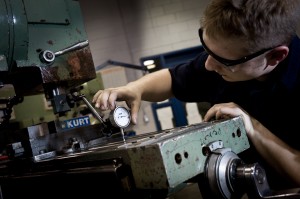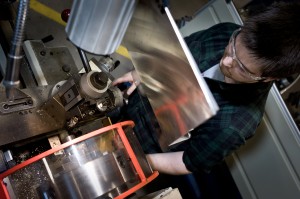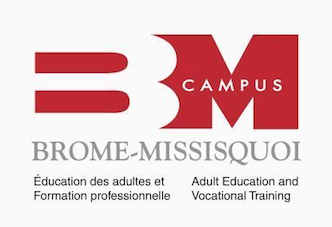 NEXT STARTS:
AUGUST 27, 2018
NEXT STARTS:
AUGUST 27, 2018OCTOBER 2, 2018
NOVEMBER 5, 2018
DECEMBER 3, 2018
JANUARY 8, 2019
FEBRUARY 4, 2019
MARCH 4, 2019
APRIL 1, 2019
MAY 6, 2019
JUNE 3, 2019
Program objectives
To develop in the students the basic competencies required to carry out machining tasks, to perform machining tasks on conventional machine tools, to perform programming tasks, to perform machining tasks on numerical control machine tools, to actively participate in multidisciplinary teams and to integrate harmoniously into the school and work environments.
 Admission conditions
Admission conditions
To be eligible for admission to this program, candidates must meet one of the following requirements:
Persons holding a Secondary School Diploma or its recognized equivalent, for example, an Attestation of Equivalence of Secondary V studies, or a postsecondary diploma such as the Diploma of College Studies or a Bachelor’s degree
OR
Persons who are at least 16 years of age on September 30 of the school year in which their training is to begin and have earned the Secondary IV credits in language of instruction, second language, and mathematics in the programs of study established by the Minister, or have been granted recognition for equivalent learning
OR
Persons who are at least 18 years of age upon entry into the program and have the following functional prerequisites: the successful completion of the General Development Test (see the following table), or recognition of equivalent learning
OR
Persons who have obtained Secondary III credits in language of instruction, second language and mathematics in programs established by the Minister are required to pursue general education courses, concurrently with their vocational training, in order to obtain the Secondary IV credits they lack in language of instruction, second language, and mathematics in programs established by the Minister.
Targeted professions (Link to Emploi Québec’s IMT En ligne)
Machining tool operators (9417)
Machinists and machining and tooling inspectors (7231)
Tool and die makers (7232)
Functional prerequisites
A person who has reached the age of 18 can be admitted to a program of study leading to a Diploma of vocational studies (DVS) based on functional prerequisites. These prerequisites, in place for those aged at least 18 years at the start date declared for the vocational training program, are: successful completion of the general development test (GDT) and obtaining and passing the tests relative to the specific prerequisites in the language of instruction and mathematics, if applicable.
This table indicates the new course codes for common core basic education (CCBE) and diversified basic education (DBE) required for the specific prerequisites in the language of instruction and mathematics for the targeted program of study. In the cases where the new course codes for the CCBE and the DBE are in progressive implementation, the old codes are indicated in parenthesis and are still valid. The equivalent course codes in basic education in the youth sector are also indicated in the table. When a DVS does not require any specific prerequisites in the language of instruction or in mathematics, a (-) will be displayed in the appropriate field. Please note that the functional prerequisites do not apply to the attestation of vocational specialty (AVS) programs.
| Language of instruction | Second language | Mathematics | |||
|---|---|---|---|---|---|
| Adults | Youth | Adults | Youth | Adults | Youth |
| 3101-1 3102-2 (3070-3) | 632-406 | – | – | 2102-3 (2007-2) | 063-206 563-206 |
Program content
| Code | Statement of competency | Hours | Credits |
|---|---|---|---|
| 872-011 | Determine their suitability for the trade and the training process | 15 | 1 |
| 872-024 | Solve mathematical problems related to conventional machining | 60 | 4 |
| 872-035 | Interpret technical drawings | 75 | 5 |
| 872-041 | Avoid occupational health and safety risks | 15 | 1 |
| 872-054 | Take and interpret measurements | 60 | 4 |
| 872-066 | Do shop work | 90 | 6 |
| 872-072 | Interpret technical information related to materials and manufacturing processes | 30 | 2 |
| 872-083 | Sketch objects | 45 | 3 |
| 872-096 | Perform external cylindrical turning operations | 90 | 6 |
| 872-105 | Perform boring operations | 75 | 5 |
| 872-118 | Perform longitudinal and transverse machining operations on a milling machine | 120 | 8 |
| 872-125 | Cut threads on a lathe | 75 | 5 |
| 872-133 | Perform drilling and reaming operations on a milling machine | 45 | 3 |
| 872-144 | Grind flat surfaces | 60 | 4 |
| 872-153 | Adapt to new types of work organization | 45 | 3 |
| 872-162 | Become familiar with the workplace | 30 | 2 |
| 872-178 | Perform angular and circular milling operations on a milling machine | 120 | 8 |
| 872-182 | Solve mathematical problems related to numerical control machining | 30 | 2 |
| 872-194 | Program a numerical control lathe manually | 60 | 4 |
| 872-206 | Machine simple parts on a numerical control lathe | 90 | 6 |
| 872-214 | Program a machining centre manually | 60 | 4 |
| 872-226 | Machine simple parts using a machining centre | 90 | 6 |
| 872-238 | Perform complex turning operations | 120 | 8 |
| 872-248 | Perform complex milling operations | 120 | 8 |
| 872-271 | Explore the possibility of starting their own business | 15 | 1 |
| 872-286 | Enter the workforce | 90 | 6 |
| 1725 | 115 | ||
